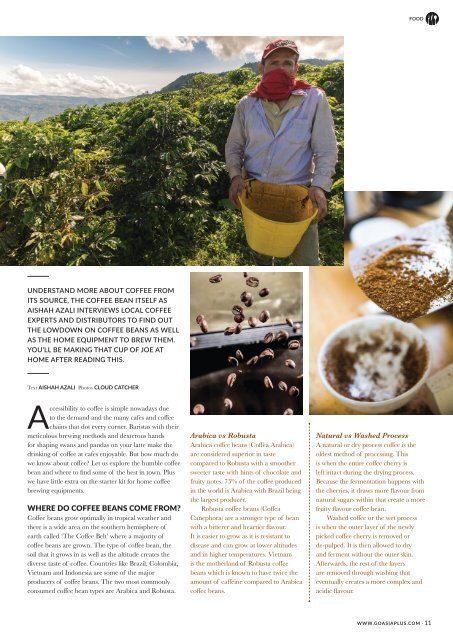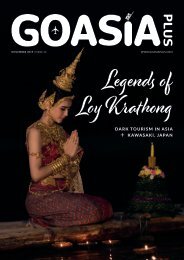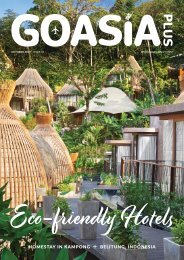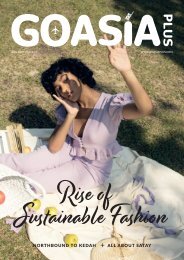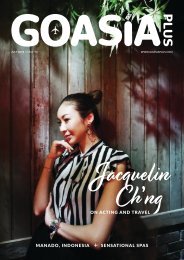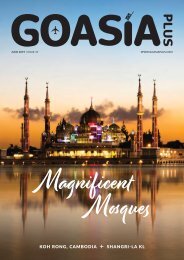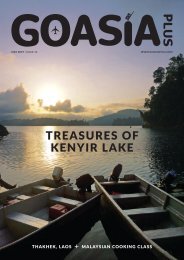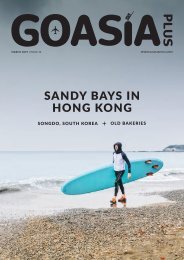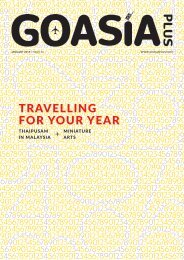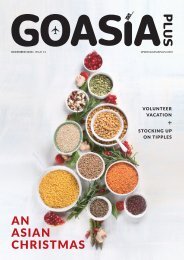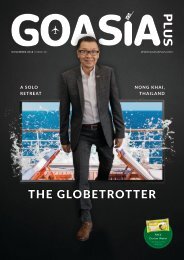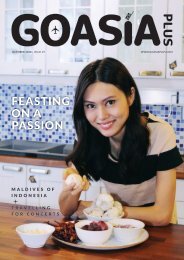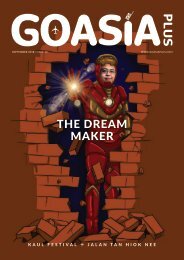GOASIAPLUS August 2018
Our August issue shines in Merdeka spirit with Kenny Loh's stories of Malaysians across the country. Inside, this issue explores a Malaysian favourite; durian and the turtle hotspot in Redang. We also featured the story behind a successful Malaysian start-up of Hometown Hainan Coffee
Our August issue shines in Merdeka spirit with Kenny Loh's stories of Malaysians across the country. Inside, this issue explores a Malaysian favourite; durian and the turtle hotspot in Redang. We also featured the story behind a successful Malaysian start-up of Hometown Hainan Coffee
Create successful ePaper yourself
Turn your PDF publications into a flip-book with our unique Google optimized e-Paper software.
FOOD<br />
UNDERSTAND MORE ABOUT COFFEE FROM<br />
ITS SOURCE, THE COFFEE BEAN ITSELF AS<br />
AISHAH AZALI INTERVIEWS LOCAL COFFEE<br />
EXPERTS AND DISTRIBUTORS TO FIND OUT<br />
THE LOWDOWN ON COFFEE BEANS AS WELL<br />
AS THE HOME EQUIPMENT TO BREW THEM.<br />
YOU’LL BE MAKING THAT CUP OF JOE AT<br />
HOME AFTER READING THIS.<br />
Text AISHAH AZALI Photos CLOUD CATCHER<br />
Accessibility to coffee is simple nowadays due<br />
to the demand and the many cafes and coffee<br />
chains that dot every corner. Baristas with their<br />
meticulous brewing methods and dexterous hands<br />
for shaping swans and pandas on your latte make the<br />
drinking of coffee at cafes enjoyable. But how much do<br />
we know about coffee? Let us explore the humble coffee<br />
bean and where to find some of the best in town. Plus<br />
we have little extra on the starter kit for home coffee<br />
brewing equipments.<br />
WHERE DO COFFEE BEANS COME FROM?<br />
Coffee beans grow optimally in tropical weather and<br />
there is a wide area on the southern hemisphere of<br />
earth called ‘The Coffee Belt’ where a majority of<br />
coffee beans are grown. The type of coffee bean, the<br />
soil that it grows in as well as the altitude creates the<br />
diverse taste of coffee. Countries like Brazil, Colombia,<br />
Vietnam and Indonesia are some of the major<br />
producers of coffee beans. The two most commonly<br />
consumed coffee bean types are Arabica and Robusta.<br />
Arabica vs Robusta<br />
Arabica coffee beans (Coffea Arabica)<br />
are considered superior in taste<br />
compared to Robusta with a smoother<br />
sweeter taste with hints of chocolate and<br />
fruity notes. 75% of the coffee produced<br />
in the world is Arabica with Brazil being<br />
the largest producer.<br />
Robusta coffee beans (Coffea<br />
Canephora) are a stronger type of bean<br />
with a bitterer and heartier flavour.<br />
It is easier to grow as it is resistant to<br />
disease and can grow at lower altitudes<br />
and in higher temperatures. Vietnam<br />
is the motherland of Robusta coffee<br />
beans which is known to have twice the<br />
amount of caffeine compared to Arabica<br />
coffee beans.<br />
Natural vs Washed Process<br />
A natural or dry process coffee is the<br />
oldest method of processing. This<br />
is when the entire coffee cherry is<br />
left intact during the drying process.<br />
Because the fermentation happens with<br />
the cherries, it draws more flavour from<br />
natural sugars within that create a more<br />
fruity flavour coffee bean.<br />
Washed coffee or the wet process<br />
is when the outer layer of the newly<br />
picked coffee cherry is removed or<br />
de-pulped. It is then allowed to dry<br />
and ferment without the outer skin.<br />
Afterwards, the rest of the layers<br />
are removed through washing that<br />
eventually creates a more complex and<br />
acidic flavour.<br />
WWW.<strong>GOASIAPLUS</strong>.COM · 11


